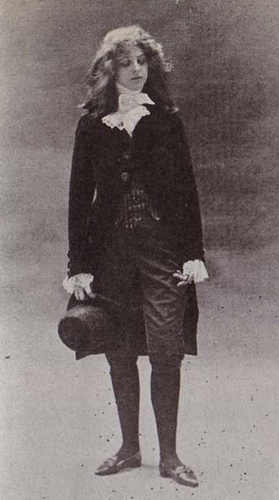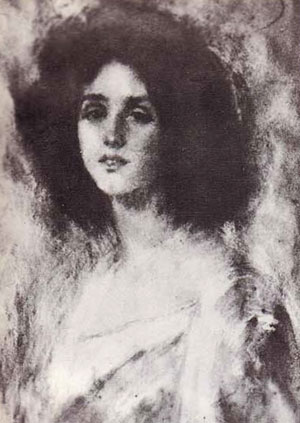Renée Vivien (Pauline Mary Tarn)

Vivien was born in London, England to a wealthy British father and an American mother from Jackson, Michigan. She grew up in Paris and London. Upon inheriting her father’s fortune at 21, she emigrated permanently to France. In Paris, Vivien’s dress and lifestyle were as notorious among the bohemian set as was her verse. She lived lavishly, as an open lesbian, and carried on a well-known affair with American heiress and writer Natalie Clifford Barney. She also harboured a lifelong obsession with her closest childhood friend and neighbour, Violet Shillito – a relationship that remained unconsummated. In 1900 Vivien abandoned this chaste love, when the great romance with Natalie Barney ensued. The following year Shillito died of typhoid fever, a tragedy from which Vivien, guilt-ridden, never fully recovered.
By 1901 the tempestuous and often jealous relationship with Natalie Barney had already collapsed. Vivien found Barney’s infidelities too stressful. When Barney spent the second half of 1901 in the United States, Vivien chose not to follow; upon Natalie’s return, she refused to see her. After their breakup, Barney never resigned herself to the separation. She made strenuous efforts to get Vivien back, efforts that did not end until the latter’s death. This included sending mutual friends to visit Vivien (in order to plead on her behalf), as well as flowers and letters begging Vivien to reconsider.
In 1902 Vivien became involved with the immensely wealthy Baroness Hélène van Zuylen, one of the Paris Rothschilds. Though a lesbian, Zuylen was married and the mother of two sons. Zuylen provided much-needed emotional support and stability. Zuylen’s social position did not allow for a public relationship, but she and Vivien often travelled together and continued a discreet affair for a number of years. In letters to her confidant, the French journalist and Classical scholar Jean Charles-Brun, Vivien considered herself married to the Baroness. She may have published poetry and prose in collaboration with Zuylen under a pseudonym, Paule Riversdale. The true attribution of these works is uncertain, however; some scholars believe they were written solely by Vivien. Even certain books published under Zuylen’s name may be, in fact, Vivien’s work.
While still with Zuylen, Vivien received a letter from a mysterious admirer in Istanbul, Kérimé Turkhan Pasha, the wife of a Turkish diplomat. This launched an intensely passionate correspondence, followed by brief clandestine encounters. Kérimé, who was French-educated and cultivated, nevertheless lived according to Islamic tradition. Isolated and veiled, she could neither travel freely nor leave her husband. Meanwhile, Vivien would not give up the Baroness de Zuylen. In 1907 Zuylen abruptly left Vivien for another woman, which quickly fuelled gossip within the lesbian coterie of Paris. Deeply shocked and humiliated, Vivien fled to Japan and Hawaii with her mother, becoming seriously ill on the voyage. Another blow came in 1908 when Kérimé, upon moving with her husband to Saint Petersburg, ended their affair.
Vivien was terribly affected by these losses and accelerated into a psychological downward spiral, already in motion. She turned increasingly to alcohol, drugs, and sadomasochistic fantasies. Always eccentric, she began to indulge her most bizarre fetishes and neuroses. Mysterious sexual escapades left her without rest for days. She entertained guests with champagne dinner parties, only to abandon them when summoned by a demanding lover. Plunged into a suicidal depression, she refused to take proper nourishment, a factor that eventually contributed to her death. The great French writer Colette, who was Vivien’s neighbour from 1906 to 1908, immortalized this aberrant period in The Pure and the Impure, a collection of portraits showing the spectrum of sexual behaviour. Written in the 1920s and originally published in 1932, its factual accuracy is questionable; Natalie Barney reportedly did not concur with Colette’s characterization of Vivien. Yet it remains a rare glimpse of the poet’s dissipated life, written by one of her contemporaries.
Vivien was cultivated and very well travelled, especially for a woman of the late Victorian and Edwardian periods. She wintered in Egypt, visited China, and explored much of the Middle East, as well as Europe and America. Contemporaries considered her beautiful and elegant, with blonde hair, brown eyes flecked with gold, and a soft-spoken androgynous presence. Before the manifestations of illness, she was well-proportioned and fashionably slender. She wore expensive clothes and particularly loved Lalique jewellery. Her Paris home was a luxurious ground-floor apartment at 23, avenue du Bois de Boulogne (now 23, Avenue Foch) that opened onto a Japanese garden. She purchased antique furnishings from London and exotic objets d’art from the Far East. Fresh flowers were abundant, as were offerings of Lady Apples to a collection of shrines, statuettes, icons, and Buddhas.
Above all, Vivien romanticized death. While visiting London in 1908, deeply despondent and ruinously in debt, she tried to kill herself by drinking an excess of laudanum. She stretched out on her divan with a bouquet of violets held over her heart. The suicide failed, but while in England, she contracted pleurisy; later, upon her return to Paris, she grew considerably weaker. According to biographer Jean-Paul Goujon, Vivien suffered from chronic gastritis, due to years of chloral hydrate and alcohol abuse. She had also started to refuse to eat. By the time of her death, she weighed about 70 lbs. Multiple neuritis caused paralysis of her limbs. By the summer of 1909, she walked with a cane.
Vivien died in Paris on the morning of 18 November 1909 at the age of 32; the cause of death was reported at the time as “lung congestion”, but likely resulted from pneumonia complicated by alcoholism, drug abuse, and anorexia nervosa. She was interred at Passy Cemetery in the same exclusive Parisian neighbourhood where she had lived. During her brief life, Vivien was an extremely prolific poet who came to be known as the “Muse of the Violets”, derived from her love of the flower. Her obsession with violets (as well as with the colour violet) was a reminder of her beloved childhood friend, Violet Shillito.
Virtually all her verse is veiled autobiography written in the French language; most of it has never been translated into English. Her principal published books of verse are Cendres et Poussières (1902), La Vénus des aveugles (1903), A l’heure des mains jointes (1906), Flambeaux éteints (1907), Sillages (1908), Poèmes en Prose (1909), Dans un coin de violettes (1909), and Haillons (1910). Her poetry has achieved greater appeal and a wider audience, as have the works of Natalie Clifford Barney, due to the contemporary rediscovery of the works of the ancient Greek poet Sappho, also a lesbian.
Born
- June, 11, 1877
- London, United Kingdom
Died
- November, 18, 1909
- Paris, France
Cause of Death
- Pneumonia
Cemetery
- Cimetiere de Passy
- Paris, France



